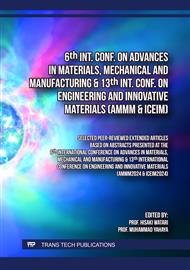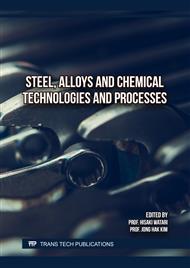p.3
p.17
p.25
p.31
p.37
p.43
p.51
p.57
Stress Corrosion Cracking of Aluminum in Chloride-Containing Solution
Abstract:
This study investigates the stress corrosion cracking (SCC) behavior of Aluminum in chloride solutions, focusing on varying bending angles (0°, 90°, and 180°), temperatures (25°C, 35°C, and 45°C), and NaCl concentrations (1%, 2%, and 3.5%). Bending tests using a universal testing machine and corrosion tests employing the open circuit potential (OCP) method and anodic polarization Tafel method were conducted. Results revealed that the highest balanced potential (-0.33684 V) occurred at a 0° bend angle in distilled water, while the lowest (-1.02513 V) was at a 180° bend angle in 3.5 wt% NaCl solution. The lowest corrosion rate (0.002403953 mmpy) was observed at a 0° bend angle in distilled water at 25°C, and the highest (2.18789227 mmpy) at a 180° bend angle in 3.5 wt% NaCl solution at 45°C. Surface characterization indicated significant pitting corrosion in NaCl solutions, particularly at a 180° bend angle, while no pitting was seen in distilled water. These findings highlight the substantial impact of bending angle and chloride concentration on the SCC behavior of Aluminum, providing valuable insights for its application in corrosive environments.
Info:
Periodical:
Pages:
3-16
Citation:
Online since:
June 2025
Keywords:
Price:
Сopyright:
© 2025 Trans Tech Publications Ltd. All Rights Reserved
Share:
Citation:



